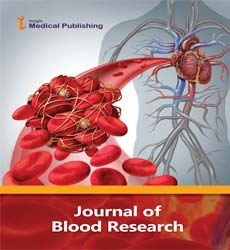Prognosis of Chronic Myeloid Lymphoma with Red Cell Distribution Width
Maryam Allahverdi Khani1* and Zahra Karimi2
1Faculty of Medicine, Najafabad Branch, Islamic Azad University, Isfahan, Iran
2Bushehr University of Medical Sciences, Bushehr, Iran
- *Corresponding Author:
- Khani MA
Faculty of Medicine, Najafabad Branch
Islamic Azad University, Isfahan, Iran
Tel: +03142291111
E-mail: allahverdy.maryam@yahoo.com
Received date: June 15, 2018; Accepted date: June 22, 2018; Published date: June 27, 2018
Citation: Khani MA, Karimi Z (2018) Prognosis of Chronic Myeloid Lymphoma with Red Cell Distribution Width. J Blood Res Vol.1 No. 1:5.
Copyright: © 2018 Khani MA, et al. This is an open-access article distributed under the terms of the Creative Commons Attribution License, which permits unrestricted use, distribution, and reproduction in any medium, provided the original author and source are credited.
Editorial
Cancer is one of the leading causes of mortality in the world and is increasing every year, as of 2017, 600920 deaths due to cancer were reported in the United States [1,2]. So, it is necessary to prognosticate these diseases.
Some simple parameters, automatically reported by laboratory blood analyzers, can have multiple clinical applications; for example, Red cell distribution width (RDW) is regularly evaluated as part of a complete blood count (CBC) for collecting information from circulatory evaluations. RDW represents the abnormal survival of red blood cells and it has a high negative predictive value (NPV) to diagnose all types of disorders; it may be useful to evaluate the short-term and long-term prognosis. Recently, RDW has been widely recognized to have an important role in carcinogenesis, tumor progression, and prognosis [3,4]. RDW has been reported as an inflammatory marker for systemic inflammatory response in many diseases. This parameter has been studied as a prognostic factor and an indicator of disease activity in many malignancies; these studies are mainly conducted in cardiovascular diseases and have been studied in very low hematological diseases.
In hematological malignancies such as chronic myelogenous leukemia (CML) who some patients have unfavorable prognosis after treatment and it is extremely variable. Many prognostic factors are used to predict clinical outcome to date treatment response indicated by cytogenic or molecular evaluation.
There have been few but valuable studies in this regard. Zack et al. concluded in their study that RDW increases in hairy cell leukemia (HCL), which is related to the activity of the disease and becomes normal after treatment. In a study, examined the significance of RDW in patients with CML that an important role in the classification of patients to predict the responses and treatment outcomes; In fact, the RDW value in CML patients is higher than normal in most cases, it may predict the treatment response, this type of classification facilitates the planning of treatment [5]. Along with the studies that confirmed a significant association between RDW and an increased risk of cancer and hematology, a study showed that RDW is stable and does not represent time-prognosis [6].
Though in previous studies relationship between elevated RDW and mortality has been reported in several contexts but in a study by Rafsanjani et al., there was a different outcome in which there was no relationship between the RDW level and the rate of mortality and relapse in pediatric patients [7]. On the other hand, Increasing RDW by age is a true biomarker of inflammatory and age-related diseases and is a major predictor of mortality [8]. That could be the reason for this difference; this connection should be further investigated in the future.
Investigating the relationship between RDW and mutations, changes in telomere length and prognosis of patients may provide a new insight into the treatment of CML. It’s suggested that in the future, the findings should be considered in larger groups, and in different treatment categories. It seems to be helpful enter RDW parameter in the routine checkup tests list for the physician in the diagnosis and treatment of disease.
References
- Mehdi Shahriari, Mohammadebrahim Jafari, Mohammad Khalafi, Mehrdad Ramezani, Massoumeh Maki, et al. (2018) Pre- and Post- birth Causes of Acute Lymphoblastic Leukemia. Int J Cancer Manag (In Press): e66448.
- Amori N, Aghajani M, Asgarian F, Jazayeri M (2017) Epidemiology and trend of common cancers in Iran (2004-2008). Eur J Cancer Care 26: e12449.
- Periša V, Zibar L, Sincic-Petricevic J, Knezovic A, Periša I, Barbic J (2015) Red blood cell distribution width as a simple negative prognostic factor in patients with diffuse large B-cell lymphoma: a retrospective study. Croat Med J 56: 334-343.
- Riedl J, Posch F, Königsbrügge O, Lötsch F, Reitter E-M, et al. (2014) Red cell distribution width and other red blood cell parameters in patients with cancer: association with risk of venous thromboembolism and mortality. PLoS One 27: e111440.
- Iriyama N, Hatta Y, Kobayashi S, Uchino Y, Miura K, et al. (2015) Higher red blood cell distribution width is an adverse prognostic factor in chronic-phase chronic myeloid leukemia patients treated with tyrosine kinase inhibitors. Anticancer Res 35: 5473-5478.
- Montagnana M, Danese E (2016) Red cell distribution width and cancer. Annals of translational medicine. Ann Transl Med 4: 399.
- Arjm K, Falahati V, Kiumarsi A, Moghaddam S, Fallahi M (2017) The Association between Red Cell Distribution Width and Mortality in Pediatric Acute Lymphoblastic Leukemia. J Neoplasm 2: 2.
- Horne BD (2012) A changing focus on the red cell distribution width: why does it predict mortality and other adverse medical outcomes. Cardiology 122: 213-215.
Open Access Journals
- Aquaculture & Veterinary Science
- Chemistry & Chemical Sciences
- Clinical Sciences
- Engineering
- General Science
- Genetics & Molecular Biology
- Health Care & Nursing
- Immunology & Microbiology
- Materials Science
- Mathematics & Physics
- Medical Sciences
- Neurology & Psychiatry
- Oncology & Cancer Science
- Pharmaceutical Sciences
